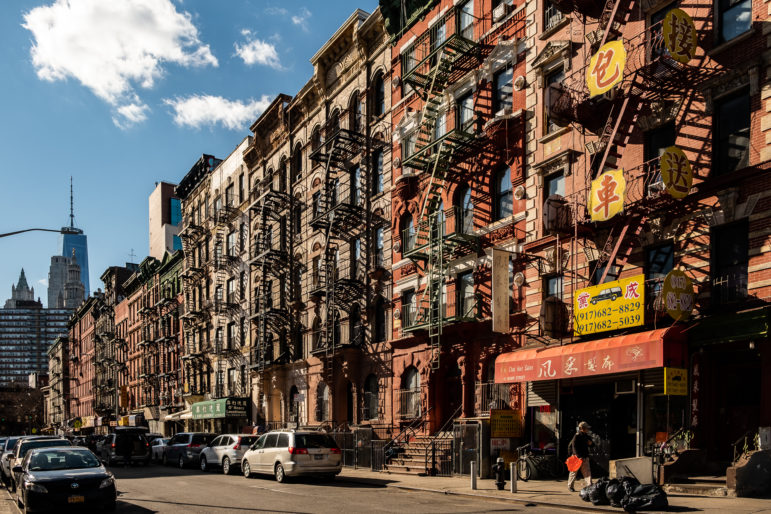
Adi Talwar
Henry Street running West from Market Street in the Two Bridges neighborhood of Manhattan.
I was thirteen years old when my mom moved us into a two-bedroom apartment in a little known nook of the city now known as Two Bridges (located on the East River between the Manhattan and Williamsburg Bridges).
It was 1979 and, being poor and single, she could only afford Section 8 housing. In those days riverfront property on the incredibly polluted East River was by no means a hot commodity; it was where the city housed its poor people.
But over the decades as the city cleaned the trash off the ground and extracted some of the chemicals from the river, the area became more attractive. And sure enough our little-known neighborhood attracted the interests of wealthy land developers looking to make a quick buck.
Growing up, when I looked around the neighborhood over the decades, I saw the same community gathering at Path-Mark, our largest grocery store. I saw old ladies talking to neighbors on the sidewalk from their first-floor windows and old men sitting on park benches and playing dominoes. It was a place where I was surrounded by familiar faces; faces of friends that I went to school with and grew up with. But developers can only see two things: land and air rights.
Since I’ve lived in Two Bridges, there have been new developments, like the Extell Tower and proposals of others like it that were clearly conceived with no attention to how they would impact the neighborhood’s infrastructure. After these new proposed towers fill up, buses in and out of our neighborhood will be terribly crowded. Lines at the grocery store and bodegas may double or more likely those mom & pop shops will be chased out by increased rent. Suddenly, our neighborhood will be less livable.
To make matters worse, in 2004, ownership of the building I live in was transferred to a new landlord hell-bent on driving out the building’s older long-term residents, renovating their units and then renting them out at much higher rates that current tenants can’t afford. Units that used to be homes for generations of families are now filled with four to five millennials, either struggling to make it in the city or living off their trust funds. This once family oriented building has become a veritable college dorm with young college aged folks smoking marijuana, vaping and drinking alcohol openly on a new posh rooftop deck.
The building now houses two tiers of living for two classes of renters. Upper-middle class tenants who pay market rate enjoy free access to the building’s new fitness center, while long-term residents must pay extra. These wealthier tenants also enjoy brand new appliances and are given first priority when they report maintenance issues. Meanwhile, rusted pipes, creaky cabinets and shoddy parquet flooring have received spot repairs and otherwise have been in my apartment since 1979.
You would think a city like New York would have some sort of accountability and oversight measures in place to prevent this predatory invasion of communities, and it indeed it does: It’s called the City Council. But last winter another agency, the New York City Department of City Planning deliberately circumvented the council’s oversight when it told the City Planning Commission that it had to approve four mega towers proposed to be built right on top of existing buildings. DCP told the commission that its hands were tied.
Get the best of City Limits news in your inbox.
Select any of our free weekly newsletters and stay informed on the latest policy-focused, independent news.
Tenants in my building and our neighbors have sued the city to ask a judge to rule that vote entirely improper. We cannot stomach more than 15,000 potential new residents in our small corner of Manhattan without the commission concluding that our neighborhood will not be adversely impacted. The commission didn’t even consider that question. Several commission members understood that DCP was leading them astray and voted against approving, but their opposition was not enough to get the city to the right side of the law. The commission should have never considered the mega towers without taking their impacts on us into account.
The battle of Two Bridges may seem far removed from someone living on the other side of the borough, but, in truth, it’s just the latest in an effort by developers to make quick money at the expense of residents and neighborhoods. Our attorney, Paula Segal, who is with the Equitable Neighborhoods Practice TakeRoot Justice (formerly the Community Development Project), tells me that she and her organization represent residents around the city who are being squeezed out of their homes and neighborhoods to make room for more expensive housing. Two Bridges is one of many neighborhoods being threatened by unchecked development, from mega towers to big box stores.
The story of development in the Two Bridges neighborhood is a cautionary tale. All New Yorkers who care about our city’s rich history of strong, vibrant communities should demand that the city put the brakes on the mega towers slated for Two Bridges now because if can happen on my street, it can happen on yours.
Marc Richardson, who has lived in the neighborhood since 1979, is the Vice President of Tenants United Fighting for Lower East Side.








One thought on “Opinion: Regulating Development is the City Council’s Job. Let Them Do It.”
You trust your CC member to figure it out?
Peter Vallone said back when the Charter changes went through in 1989 that individual CC members would never be allowed to veto economic development. How wrong he was. Re-zonings are being held hostage to CC community-Benefit-Agreements meant to reward the local member. Not meant to be! Our next batch of Charter changes in November don’t go near it.